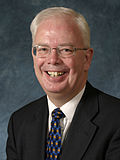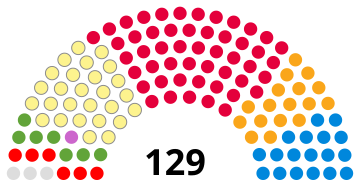Top Qs
Timeline
Chat
Perspective
2003 Scottish Parliament election
From Wikipedia, the free encyclopedia
Remove ads
The 2003 Scottish Parliament election was the second election of members to the Scottish Parliament. It was held on 1 May 2003 and it brought no change in terms of control of the Scottish Executive. Jack McConnell, the Labour Party MSP, remained in office as First Minister for a second term and the Executive continued as a Labour and Liberal Democrat coalition. As of 2023, it remains the last Scottish Parliament election victory for the Scottish Labour Party, and the last time the Scottish National Party lost a Holyrood election.
This article needs additional citations for verification. (December 2020) |
The results also showed rises in support for smaller parties, including the Scottish Green Party and the Scottish Socialist Party (SSP) and declines in support for the Labour Party and the Scottish National Party (SNP). The Conservative and Unionist Party and the Scottish Liberal Democrats each polled almost exactly the same percentage of the vote as they had in the 1999 election, with each holding the same number of seats as before.
Three independent MSPs were elected: Dennis Canavan, Margo MacDonald and Jean Turner. John Swinburne, leader of the Scottish Senior Citizens Unity Party, was also elected. This led to talk of a "rainbow" Parliament, but the arithmetic meant that the coalition of Labour and Scottish Liberal Democrats could continue in office, which they did until the 2007 election.
The decline in support for the SNP was viewed by some as a rejection of the case for Scottish independence. Others argued against this, pointing out that the number of MSPs in favour of independence actually rose because most of the minor parties such as the SSP share this position with the SNP.
Remove ads
Retiring MSPs
At the dissolution of Parliament on 31 March 2003, ten MSPs were not seeking re-election.[1]
Remove ads
Campaign
The parliament was dissolved on 31 March 2003 and the campaign began thereafter.
Party leaders in 2003
- Labour – Jack McConnell
- SNP – John Swinney
- Conservative – David McLetchie
- Liberal Democrat – Jim Wallace
- Greens – Robin Harper & Eleanor Scott (co-chairs)
- SSP – Tommy Sheridan
Defeated MSPs
Labour
SNP
The New Party
- Keith Harding, Mid Scotland and Fife (elected as a Conservative)
- Lyndsay McIntosh, Central Scotland (elected as a Conservative)
Results
Summarize
Perspective

Notes:
- The Scottish Greens did not stand in any constituencies, instead concentrating their resources on winning the largest possible share of the "second" vote for 'list' seats.
Remove ads
Constituency and regional summary
Central Scotland
Glasgow
Highlands and Islands
Lothians
Mid Scotland and Fife
North East Scotland
South of Scotland
West of Scotland
Remove ads
Coalition
As part of the coalition deal between Labour and the Scottish Liberal Democrats, Labour allowed proportional representation (a long-standing Lib Dem policy)[3] to be used in Scottish local government elections.[4][5] This system was first used in 2007.[6]
Campaign spending
See also
References
Party manifestos
External links
Wikiwand - on
Seamless Wikipedia browsing. On steroids.
Remove ads








